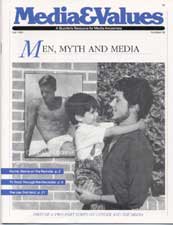How do Media Images of Men Affect Our Lives?
|
This article originally appeared in Issue# 48
|
Re-Imagining the American Dream
Turn on your television set and there is about a 90 percent chance that the first person you view will be male. Yet, although men predominate on TV, questions come up frequently about the types of men portrayed. How do they relate to the men we know in our daily lives?
Very often it seems clear that they differ a lot. Primarily, they are less real, more perfect and more predictable. In other words, they are stereotyped.
A stereotype is a view or a characterization of a person or a group of persons based upon narrow and frequently incorrect assumptions. Stereotypes are used by those who cannot or will not take the time to notice what a person is really like. They are particularly common in media because they are easier to create. Audiences and media production personnel both respond to them.
Virtually all groups of people suffer from stereotyping and men are no exception. Stereotypes are powerful because they affect our expectations of what men should and should not be like. They are damaging because they narrow our notions of what men can be and do. They affect women's expectations of men in relationships and men's expectations of other men in work settings or in friendships. Media stereotypes have extra impact because they create images based on these assumptions, helping to shape men's own views about how they should act and how successful they are as men.
Sexual stereotyping begins early in men's lives. Boys learn what it means to be a man from family and peers. These ideas about approved behaviors and modes of thought are focused and supported by media messages.
Bravery, adventurousness, being able to think rationally, being strong and effective, for example, are all "manly" traits that are usually encouraged. So also are the ability to think independently and take the initiative. Media images supporting these behaviors include the strong, silent Marlboro man and military ads telling young men to "be all you can be." (Young women, on the other hand, are urged to pursue beauty and sex appeal.)
At the same time, males are discouraged from pursuing many positive traits that are perceived as unmanly. These include the ability to feel a range of emotions, including fear, hurt, confusion or despair. Even talking about these feelings is considered unmanly. Men are also not encouraged to learn to work cooperatively without the need for control, to love in a nonsexual way, to have friendships or to solve conflicts without violence.
These narrow masculine standards can lead to discrimination against those who deviate from them. But they can also prevent men themselves from living up to their full potential as human beings.
TV perpetuates male stereotyping in two ways. Men in key "positive" character roles are portrayed chiefly with in a restricted range of male traits. "Less manly" characteristics are usually displayed by supporting characters, as flaws in the personality of the central character or as a source of humor or difficulty.
In watching television, we need to tune into how TV treats male characters, how we relate to the characters, and how these characterizations influence our ideas about masculinity and the real men of all ages who star in our own lives.
Do we watch men on TV and feel unlike them and intimidated, or do we relate to them as real people, feel inspired and learn from them? The aware watcher can distinguish, and learn from, these reactions.
Discussion Questions
Use the following questions as a guide to your discussion about the ways men are portrayed on TV and how those images influence your perceptions and expectations of the men in your own life.
- How many of your favorite shows feature men as the principal character, the center of the plot or the action? What messages do they suggest about the importance of men in our society relative to women and children?
- List some of the roles men play on TV? How do they compare to their roles in the "real" world? How do they influence your expectations of how men actually behave?
- Select several male characters from TV programming and match them to the characteristics listed below. You may match one character to more than one characteristic.
Stereotypic Characteristics - logical thinkers
- think rather than feel
- take charge of situations
- loners
- protect women and children
- aggressive
- adventurers, take risks
- worldly wise
Non-Traditional Characteristics - sensitive to feelings
- work with others
- accept help
- emotionally expressive
- caring for children
- having harmonious relationships
- engaging in home-related activities
- having non-sexual friendships with women
- How are the characteristics displayed by men on TV comparable to those of the men in your own life? How do they differ?
- How does the portrayal of men differ in various types of programing? Do TV ads seem to portray the "new" man and sportscasting the more traditional man?
- List your own male TV heroes. What qualities attract you to them? Do any actual men you know share them?
- List the various ways men are shown on TV in relationship to other men, such as controlling/sharing, caring/abusive, fighting/friendly, etc.
- In thinking about these TV men, how do they make you (if you are a man) feel about other men? Do you feel inferior to them or do you feel validated by them? In other words, how well do men on TV function as role models, as viewing spectacles, or as people to relate to?



